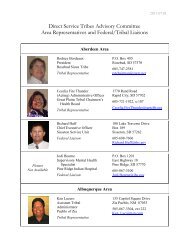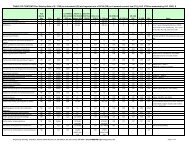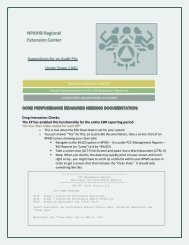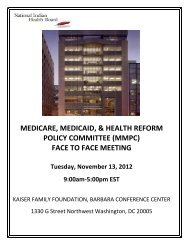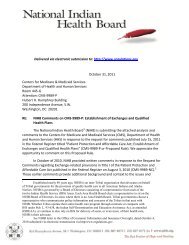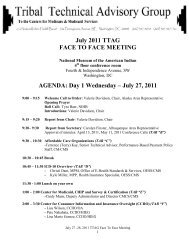âHealth Insurance Premium Tax Creditâ (IRS REG-131491-10)
âHealth Insurance Premium Tax Creditâ (IRS REG-131491-10)
âHealth Insurance Premium Tax Creditâ (IRS REG-131491-10)
- No tags were found...
You also want an ePaper? Increase the reach of your titles
YUMPU automatically turns print PDFs into web optimized ePapers that Google loves.
NIHB Supplemental Submission - Definition of Indianstatutory definition. 24 It should be noted that pueblos are also considered to be Indian Tribes,nations, organized groups, and communities recognized as eligible for the special programsand services provided by the United States to Indians because of their status of Indians. Tofurther support our contention that these definitions are not in fact different, dropping theword ―pueblo‖ from the definition would not exclude pueblos.The plain language of these definitions includes no reference to ―FederallyrecognizedTribes.‖ Instead, they all include ―organized groups and communities‖ includingAlaska Native regional and village corporations.3.1.1 Other Organized Groups and Communities – Alaska NativeRegional or Village Corporations.The Alaska Native Claims Settlement Act (―ANCSA‖) 25 was enacted in 1971 in orderto settle land claims by Alaska Natives. Although ANCSA had the effect of extinguishingthe Indian reservations in Alaska 26 and transferring title of selected lands to Alaska Nativeregional and village corporations, it did not eliminate the special trust relationship of theUnited States to Alaska Natives.One consequence of ANCSA was, however, that tribal identity in Alaska began to bedefined by reference to Alaska Native Corporations (―ANCs‖) as well as, and often to agreater degree than, enrollment in a Tribe. In recognition of this, all three definitions ofIndian used in the ACA treat the ―regional or village corporation as defined in or establishedpursuant to the Alaska Native Claims Settlement Act [cit.om.]‖ as ―Indian tribes‖ for thepurposes of defining who is an ―Indian,‖ although they are certainly not ―FederallyrecognizedIndian tribes‖ as that term is often employed. 27 Nor is the inclusion of ANCslimited by the final clause referencing eligibility for special programs and services providedby the United States for Indians because of their status as Indians. 282425 C.F.R. § 900.6 (HHS and Department of the Interior (―DOI‖) Title I), 25 C.F.R. § <strong>10</strong>00.2(DOI Title IV), 42 C.F.R. § 137.<strong>10</strong> (Title V). These regulatory definitions also include ―rancheriasand colonies.‖2526Alaska.27Pub.L. 92-203, § 2, 85 Stat. 688, codified as amended at 43 U.S.C. § 1603 et seq.The exception to the extinguishment was the Metlakatla Indian reservation in SoutheastE.g., in the Preamble to the Exchange Establishment NPRM, the phrase ―Federallyrecognizedtribes‖ is treated as synonymous with the list of Tribes as defined ―in the FederallyRecognized Indian Tribe List Act of 1994, 25 U.S.C. 479a.‖28Cook Inlet Native Ass’n v. Bowen, 8<strong>10</strong> F. 2d 1471, 1474 (9th Cir. 1987) (―Regionalcorporations appear to be included specifically in the Self-Determination Act definition, yet CINAcontends they are excluded by the eligibility clause. CINA asserts that the clause modifies ‗regionalcorporation‘ and therefore, to be a tribe, the corporation must ‗be recognized as eligible for the specialprograms and services provided by the United States to Indians because of their status as Indians.‘ 25U.S.C. § 450b(b). CIRI is not eligible for special programs because of its status. However, the statuteshould not be interpreted to render one part inoperative . . . .‖).National Indian Health Board Page 7 of 24 October 31, 2011




